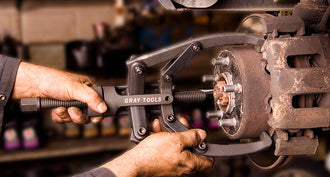5 Strategies To Tackle Common MRO Issues
- Gray Tools Official Blog
- 11 Jul, 2016
Maintenance, repair and operations (MRO) refers to the process of repairing any out-of-order equipment and machines (unscheduled maintenance) and also taking precautionary measures to ensure that equipment does not break down in the future (preventative maintenance) so that a business can continue to operate.
However, on the whole, these MRO issues could be handled much more efficiently, especially given the fact that MRO inventory can account for up to 40 percent of a given businesses’ budget. To maximize efficiency and productivity, here are five strategies a millwright should keep in mind in order to better address common MRO issues.
An Organized and Clean Storeroom
One common problem when it comes to MRO issues is a lack of an organized storeroom
they are often disorganized and dirty. If tools cannot be located in a quick manner, productivity levels drop drastically.
Each type of part should be stored in its own location and should be taken out of their boxes. Aisles should not be cluttered, and shelves should be in good condition so they are not safety hazards. The storeroom should be tidy, clean of spills and dust-free.
Proper Inventory Management and MRO Inventory Performance
Another critical part of an efficient storeroom is having supplies stocked, which involves
having a proper inventory management system in place. This highlights one of the major
problems when it comes to MRO management: failure to tightly measure and monitor
supplies in the same way that other inventory is tracked and controlled.
This might include tracking lubricants, cleaning supplies, office supplies or even furniture. However, these supplies are not tracked with the same attention to detail when they should be. It is a common occurrence for excess supplies to simply be lying on a skid without any pertinent information attached to it, like a locator system or how much of the supply is being used.
To remedy this common MRO problem, businesses should consider having a supplier
come in and take inventory of parts and replenish as necessary. Supplies make up a
significant cost and therefore should be tracked and controlled. You will simply be left with a monthly invoice. Not only will an inventory management system ensure that you don’t run out of supplies, but it will also reduce unnecessary purchase orders and therefore lead to a lot of savings.
In short, MRO supplies should be tracked and managed.Hhaving a third party do this allows staff to focus their valuable time elsewhere. This management system will also ensure that excess inventory isn’t simply lying out on skids and waiting to become a safety hazard.
Additionally, this trackable information should be the basis for MRO Inventory Performance, and should be provided to management on a monthly basis so that they can evaluate and make adjustments to the budget as necessary, leading to increased savings. For example, if usage is measured, purchase orders will be kept to a minimum.
Central Location of Inventory and Removal of Individual Inventory
Another common issue when it comes to MRO issues is the fact that the necessary
supplies to carry out MRO tasks cannot be located. In fact, often this is more of a problem than having a lack of supplies. Tracking supplies and/or having them in an organized location, which the supplier will take of, will ensure that they are easily accessible. This will also ensure that emergency supplies do not have to be expedited at a high cost.
A secondary problem as it relates to the location of inventory is in relation to certain
individuals keeping private inventory for their own use.That is, they keep their supplies
hidden from others so that they can get items more easily.
However, this is very costly to any business. All inventory should be in a central location that is easily and openly accessible to all parties.
Computerized Maintenance Management Systems
In addition to having an organized and stocked space, computerized maintenance
management systems can help businesses remember to schedule necessary time for
maintenance of machines, both preventive and predictive. The lack of these systems in
place is another issue when it comes to MRO issues.
Preventing any machines from going into unscheduled disrepair (and avoiding unplanned downtime) will ultimately ensure that productivity levels are maximized and that lost revenue from unexpected downtime does not affect the business. This is extremely important when you consider that it can go on to significantly affect profit and customer’s views of your business.
Education for MRO Staff
MRO staff should have the option to attend seminars on MRO management. This
education might include supply chain information, for example, but in general it is a way
for MRO staff to become knowledgeable about the best practices of MRO management.
Over time, the following tools will make MRO management much more efficient and will allow your company to increase overall profitability.



